The seatbelt sign lights up, signaling that our descent into Ouarzazate in Morocco has begun. Through the window, the plane’s shadow grows larger as we approach the ground. It reflects among the dry browns of the rugged terrain, continuing to bathe in the waters of the dam that supplies the city. Then, it travels over the rooftops of the most important city in the Draa region. The adventure has begun!
Preparations for a trip through Morroco
Ryanair began operating a new route between Madrid and Morocco last October. The city of Ouarzazate, south of the High Atlas, was added to the Irish airline’s destinations, bringing us closer to the gateway of the desert and facilitating a short and different getaway.

The Moroccan Sahara Desert is one of those places that every traveler has on their list. So close to us and yet so far, so unknown and so magical. If you are also one of those who prefer independent routes, Morocco is your destination.
How to get to and get around Morocco
Many Moroccan cities are connected to the main European capitals. For this specific itinerary, a direct flight to Ouarzazate is possible from Madrid on Tuesdays and Saturdays.
The best way to reach the desert is by hiring a guide-driver or by renting a car, preferably an SUV. For greater comfort and safety, in this case, at LyxPlanet, we opted to find a guide-driver. It would facilitate access to places full of authenticity, as the intention was to take advantage of the trip to do The Route of the Thousand Kasbahs, we would ensure not getting lost and save time to see as many places as possible, and we would learn more about the local culture.
After contacting several guides, Hamid, from the agency Corazón de Marruecos, presents himself as the best candidate: he quickly answers all doubts and provides solutions to the proposals we make. So, we decided to rely on the service of this Berber from Khamlia. Who better than him to pursue authenticity in small villages like Khamlia? Without a doubt, he ends up becoming the best guide and companion for our trip.
We highlight his friendliness, always leaving space for the traveler’s privacy, his caution driving, and the wide range of completely new SUV cars he makes available to clients. It feels good to know you’ve chosen the most important part of the trip well.

Is it necessary to get a visa to travel to Morocco?
People of Spanish nationality only need to have a valid passport to enter Morocco. The same applies to most countries in America. Both upon arrival and departure, it will simply be necessary to fill out a small form and hand it over when passing through passport control.
The website of the Moroccan Ministry of Foreign Affairs offers more information on this.
Currency
The currency used in Morocco is the dirham. There are banknotes of 20, 50, 100, and 200 dirhams. At the exchange rate, 100 dirhams are approximately equivalent to just under 10 euros.
It is advisable to carry enough cash, as many establishments do not accept credit card payments.
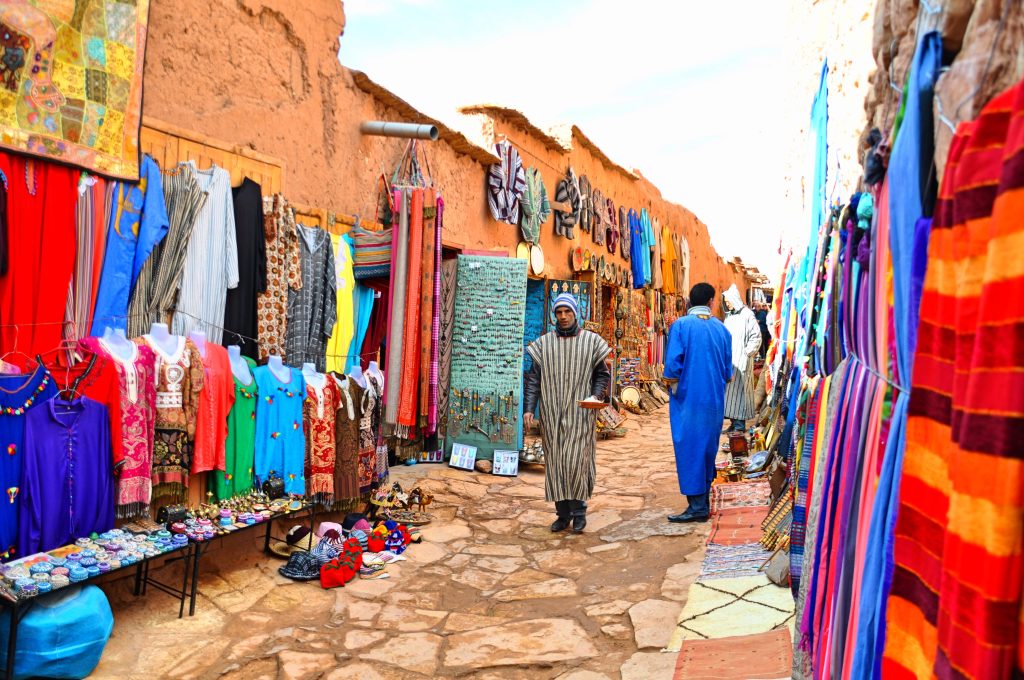
Language
Arabic is the official language of the country, but due to its past, French is also widespread. However, both Spanish and English are taught in most schools due to their openness to tourism.
Even in the most hidden corners of this itinerary, it will be possible to find someone who speaks Spanish.
Climate
What is the best time to travel to Morocco?
The temperature in Morocco varies greatly depending on the time of year and fluctuates quite a bit between day and night, especially in winter. In autumn, it is usually the rainy season. In summer, the thermometer can reach 40 degrees and even experience a sandstorm. Spring is perhaps the best season to visit the country, with milder and more pleasant temperatures.
FOUR-DAY ITINERARY THROUGH MOROCCO
Day 1. Ouarzazate, the City of Cinema
As soon as we land in Ouarzazate, we head to Atlas Studios, on the outskirts of the city. These Film Studios were responsible for the economic growth of the area since their inauguration. The surrounding landscape immerses us in the scenarios of the films that were shot here: Lawrence of Arabia, The Mummy, Gladiator, Asterix & Obelix: Mission Cleopatra, The Jewel of the Nile…
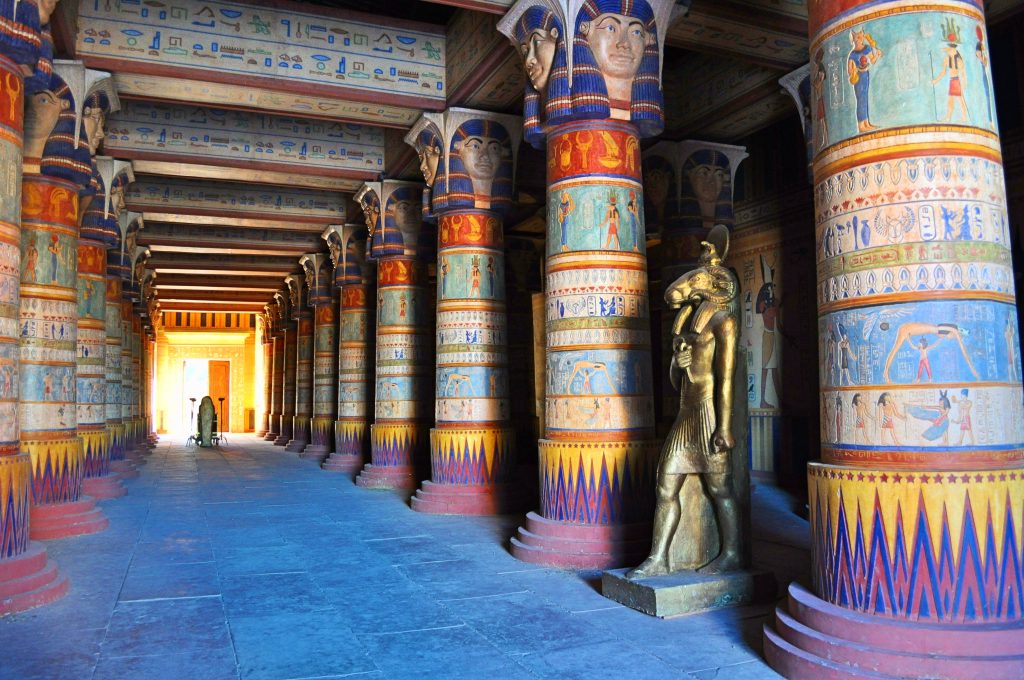
During the tour, we will see some of the sets that are still maintained: an Egyptian temple, the slave market from Gladiator, the fighter plane used in The Jewel of the Nile by Michael Douglas. The visit is just curious and dispensable if the traveler does not have extra time, as the facilities have a somewhat decadent air. As a curiosity, note that Ouarzazate has also hosted two other less emblematic studios: Kanzaman and CLA Studios.
We move to the city center to see what is undoubtedly its main attraction: the Taourirt kasbah. This building, made of adobe and declared a World Heritage Site by UNESCO, will be the first of many on our journey through the Route of the Thousand Kasbahs to reach the desert. And the kasbahs represent the traditional architecture of the area and, during the trip, will immerse us in fascinating stories of the families who lived in them.
The Taourirt palace was commissioned by the powerful Berber family El Glaoui in the 18th century for the gold route between Marrakech and Timbuktu. Its simple exterior hid an opulent interior with rich polychrome wood decoration. The surroundings of the palace are made up of labyrinthine streets that bring us closer to the most authentic local life, making us participate in it.

Before nightfall, we head to Al Mouahidine Square, walking along Mohamed V Avenue, the city’s main artery, where there are good restaurants to enjoy the country’s delicacies. This is the case of the Jardin des Aromas Restaurant, an elegant establishment that serves rich Moroccan dishes. Opposite the restaurant, Al Mouahidine Square and the vibrant market give us another piece of daily life in Ouarzazate.
Day 2. From Ouarzazate to the Sahara Desert via Route 9
We leave Ouarzazate to travel the 360 kilometers that separate us from the desert. Along the way, canyons, mountains, and many kasbahs will give us wonderful panoramic views of the region.
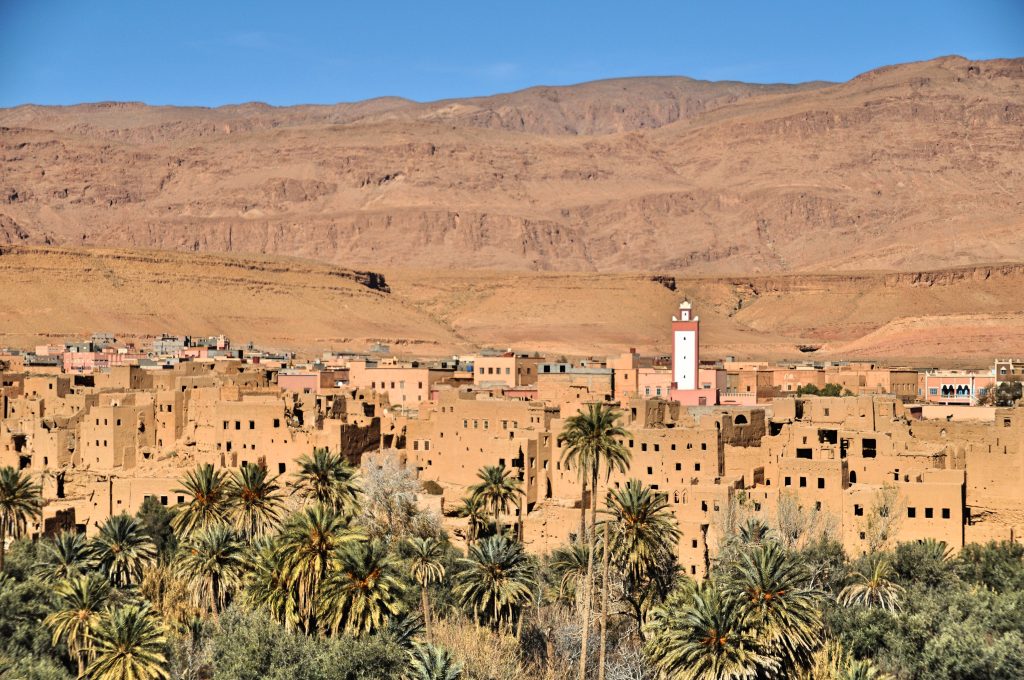
To reach our destination, we can do it via Route 10, towards Tinerhir, or via Route 9, passing through Tamnougalt. Hamid recommends going via the latter to stop at one of the points we have marked on the route: the Rissani market. This old market only opens on Sundays, Tuesdays, and Thursdays; something we must take into account when organizing the trip.
We head towards the desert via Route 9, Hamid hits play, and the music of the Tuareg group Tinariwen becomes the soundtrack of the trip. We are already immersed in the Berber culture!
We cross the Small Atlas of black and reddish tones, observing the sparse vegetation that dots the steep mountains. As we advance, the contrast of the landscape becomes more noticeable. Capricious rock formations accompany us along the way, and we cannot avoid stopping at one of them converted into a canyon.
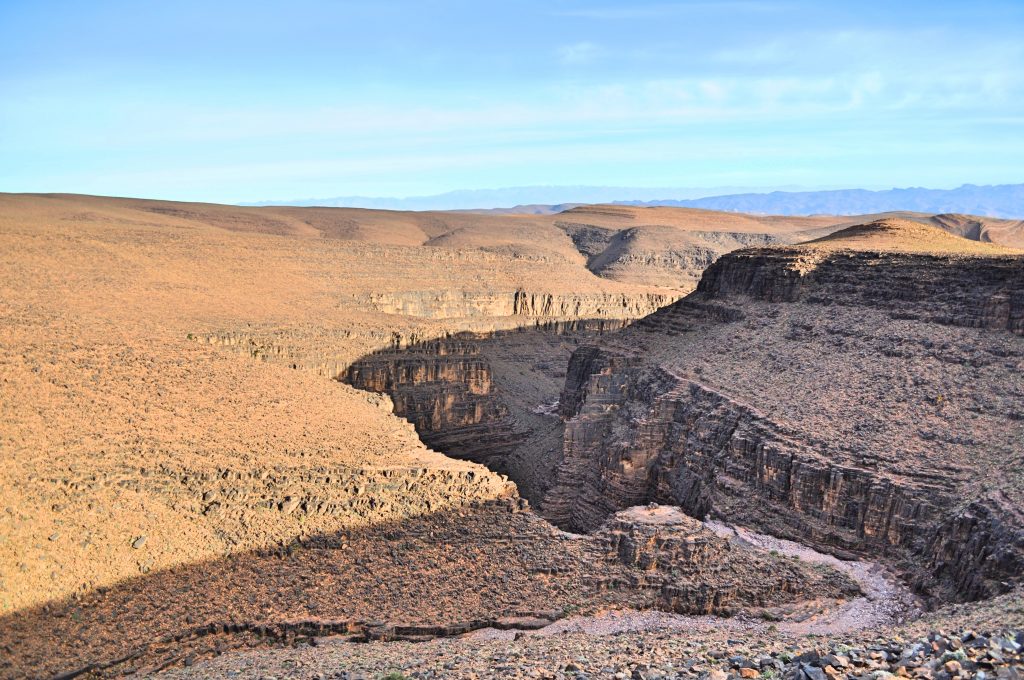
The journey continues between acacias, impossible hills, and palm groves that emulate splendid oases. The most impressive on the route will be the Agdz and Nkob palm groves, a little further on.
After a short break in Agdz, we arrive at the town of Tamnougalt, or as it is also known, “the mother of all castles.” In Tamnougalt, the Kasbah des Caids is famous, dating from the 17th century. At the entrance, some boys wait to collect the 20 dirham entrance fee and guide us through bare rooms in twilight. To finish getting lost in the past of these typical constructions, we walk through the surrounding alleys that, among the nooks of their walls, reveal the barren lands and the Atlas mountains.
15 minutes away, the hidden Timiderte kasbah awaits the few tourists who reach it. The reception is somewhat more desolate due to its semi-abandoned state. At the entrance, a donkey lies dying on the ground.
Tazarine and Rissani will be the last stops at the gateway to the desert. Rissani was an important commercial location in the 14th century, a tradition that has continued to be preserved by its popular market. It sells everything from shoes to sheep and goats, passing through all kinds of food. The smells, colors, and tradition are the protagonists of the vibrant life in Rissani on Tuesdays, Thursdays, and Sundays.

The desert, closer and closer, awaits us with its infinite sea of dunes. At the meeting point agreed with the owner of the camp where we will stay, some dromedaries await us to take us to our haima. A one-hour journey between dunes immerses us in the peace and mysticism of the desert. Once at the camp, we get off the dromedaries and climb to one of the highest dunes to enjoy the sunset. The golds of the sand are accentuated while the sky is tinged with oranges that gradually turn into pinks.
Before the last lights of sunset dissipate, we discover, Before the last lights of sunset dissipate, we discover, stunned, our accommodation, Caravanserai Luxury Desert Camp: chill-out areas with wonderful views, a bonfire to face the cold nights, a haima restaurant where we are served a copious and delicious dinner based on typical dishes (tagine and couscous are just some of them) and eleven tents with private bathrooms, king-size beds and all the accessories that can be found in a normal hotel. I would never have imagined that a camp lost in the desert could be so full of details. Of course, there is also Wi-Fi connection; completely disconnecting is a choice within everyone’s reach.
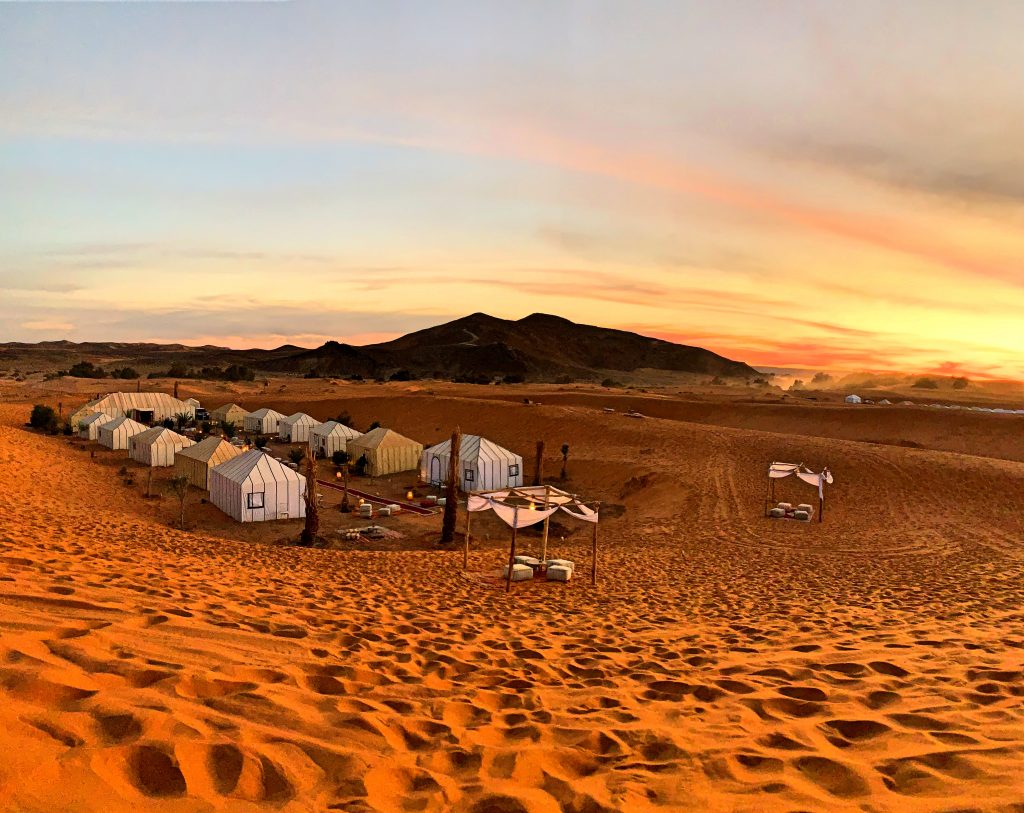
The most special moment of the trip comes when, next to the bonfire, the Berber music of the camp workers takes center stage under the starry sky.
Day 3. From the Desert to the Dades Gorge via Route 10
Waking up early is not easy, especially if it means leaving the warmth of the countless blankets that cover the bed. I have even slept with my hat on to withstand the two degrees below zero that the thermometer has marked; not everything was going to be comfort in the desert! But waking up early with the purpose of witnessing the colors of the sun reappearing among dunes is not so complicated after a hot shower. I surprise myself by leaving the haima and realizing that I am the first to have gotten up. I take a seat in one of the chairs that surround the camp dunes, dressed in all my cold-weather gear. Then the show begins.
At the foot of the Erg Chebbi dunes is Khamlia, the first stop of the day. We get there in Hamid’s car. After the experience of the dromedary ride the previous day, I have sore muscles and consider that my adventurous zeal has been enough for the moment.
Hamid’s town was founded in the 1950s by the descendants of slaves, brought in caravans across the desert from southern Africa. Of Gnawa and Berber ethnicities, they are known for their musical culture, so they entertain us with the music of their drums, the sound of the desert.
On the itinerary through Route 10, we greet a friendly desert fox, pass by fossil houses (traces of an unparalleled prehistoric past), meet nomadic families who live next to wells they draw from, and experience local life as we pass through Arab towns (Jorg) and Berber towns (Toirog or Mlaab and its simple cemetery at the entrance).

The town of Erfoud, where Arabs and Berbers coexist, is another perfect stop to see fossils and try the dates, so popular in the area. If we happen to be here in October, we can also enjoy its famous Date Festival.
There is no shortage of visits to kasbahs on today’s route, such as the well-preserved El Khorbat and its comprehensive museum, where, for 20 dirhams, we can learn about the life of these fortifications. The enormous Jewish kasbah of Todra, on the way to the gorge of the same name, will witness another of the many impressive panoramas that decorate Route 10.
Once in the Todra Gorge, we walk along a stream located between large gorges. How wonderful nature is!

The Dades Gorge is another essential natural enclave on this route. To visit it, it will be necessary to make the journey that separates Boumalne Dades from Msemrir, about 30 kilometers of winding roads over which very photogenic small towns hang. The Tamlalt cliffs, better known as “monkey fingers,” will be one of the most special enclaves in the gorge.
Day 4. From the Dades Valley to Ait Ben Haddou
We wake up early to let ourselves be conquered by the last photographs of the Dades and head to the last destination of the trip: Ait Ben Haddou.
We advance between new valleys and arrive at the Valley of Roses, which has its culminating scene in spring, when thousands of roses unfold all their color. In Kelaat M’Gouna, we can get products made from these flowers. This town celebrates the Rose Festival in May, a celebration that brings together hundreds of people from all over Morocco around the spectacle of the flowering.
In Skoura, we see dozens of abandoned kasbahs surrounded by palm trees. We visit the Amridil Kasbah. More labyrinthine rooms full of old utensils, large terraces with views of palm groves, and a simple facade decorated with geometric motifs. It could be the same as all the ones we have seen so far, but no, this one enamors us in a special way.

Following the route, we cross the mountains again, although this time the High Atlas surprises with its snowy peaks. We pass Ouarzazate, and an hour away, we arrive at Ait Ben Haddou, a town where numerous film scenes produced by Atlas Studios have been shot.
The most special access to the old part of the town is through the bus parking lot, then crossing the river by a kind of bridge made of sacks. We stop to admire that wonder of a ksar at the foot of the Atlas before entering the convoluted and colorful alleys that lead to its summit.
The last sunset in Morocco leaves us with an unforgettable image of remote lands. Those of ochre dotted with palm trees and crowned by the snowy peaks of the Atlas.
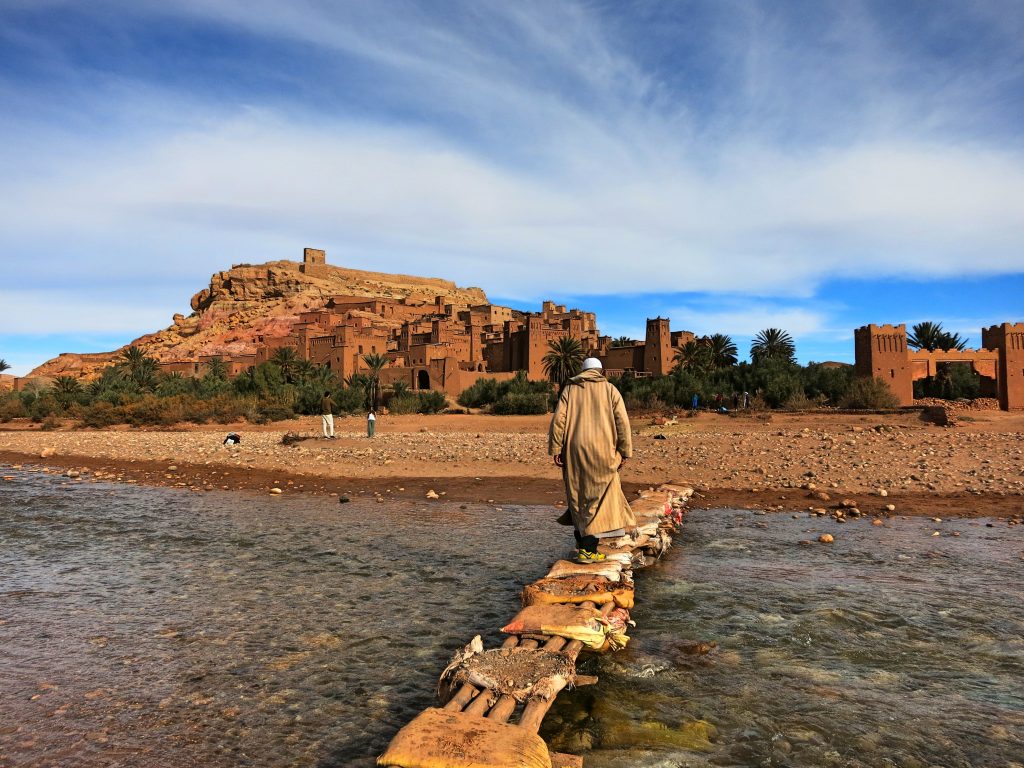
Do you want more? Check other destinations in Africa.
Recommended Hotels
If you are looking for a hotel near this wonderful experience, we recommend the Oscar Hotel by Atlas Studios. This hotel offers an excellent value for money and is located next to the Atlas Studios film studio and offers an outdoor pool and film-themed rooms.
Or you can choose to stay at the Pestana CR7 Marrakech Hotel which has an outdoor pool, fitness center, garden and terrace in Marrakech.
